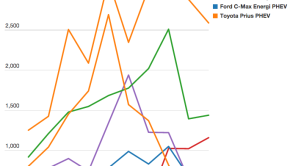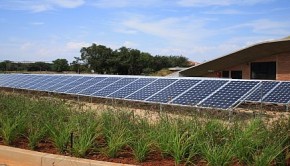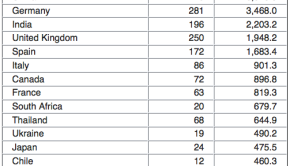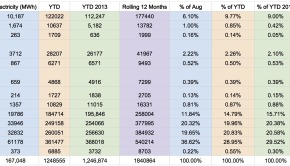Renewable Energy = 68% of New Electricity Capacity In September
November 2nd, 2014 by Zachary Shahan
The latest monthly numbers on electricity production capacity additions have been released by FERC. The result is another big month for renewable energy… and natural gas. As you can see in the first chart above, wind power accounted for the majority (61%) of new power capacity. Natural gas accounted for 19%, nuclear 12%, and solar 7%.
For the year to date, natural gas has accounted for 58% of new electricity production capacity, utility-scale solar 19%, wind 18%, and nothing else more than 2%. Together, renewables account for nearly 41% of all new capacity added in the first three quarters of 2014.
In total, the picture looks much worse (of course). 42% of US electricity production capacity comes from natural gas, 28% from coal, 9% from nuclear, 8.5% from water, 5% from wind, 4% from oil, and ~1% each from biomass and utility-scale solar.
But there is reason for hope. As the SUN DAY campaign noted in an email sent to CleanTechnica, “new capacity in 2014 from the combination of renewable energy sources thus far is almost 35 times that of coal, oil, and nuclear combined (3,598 MW vs. 104 MW).” Going on: “For the month of September alone, renewables accounted for over two-thirds of the 603 MW of new generating capacity put in-service [367 MW of wind (60.86%) plus 41 MW of solar (6.80%)].” The first three quarters of 2014 saw 11.8% more renewable energy capacity compared to the same period in 2013 (3,598 MW vs. 3,218 MW). We’re getting going. Things need to speed up, but I’m confident they will. Furthermore, here’s one more reminder that rooftop solar power is not included in these figures.
Check out more CleanTechnica reports.
Keep up to date with all the hottest cleantech news by subscribing to our (free) cleantech newsletter, or keep an eye on sector-specific news by getting our (also free) solar energy newsletter, electric vehicle newsletter, or wind energy newsletter.
-
bmarcoux
-
Bob_Wallace
-
bmarcoux
-
Bob_Wallace
-
-
-
-
http://zacharyshahan.com/ Zachary Shahan
-
Michael G
-
http://zacharyshahan.com/ Zachary Shahan
-
-
Ron Winton
-
Wayne Williamson
-
Wayne Williamson
-
Larmion
-
Ronald Brakels
-
Larmion
-
Ronald Brakels
-
Bob_Wallace
-
-
-
-
-
Marc Dorwitt
-
Larmion
-
Marc Dorwitt
-
-
-
Senlac
-
http://zacharyshahan.com/ Zachary Shahan
-
-
Steve N
-
http://zacharyshahan.com/ Zachary Shahan
-



























